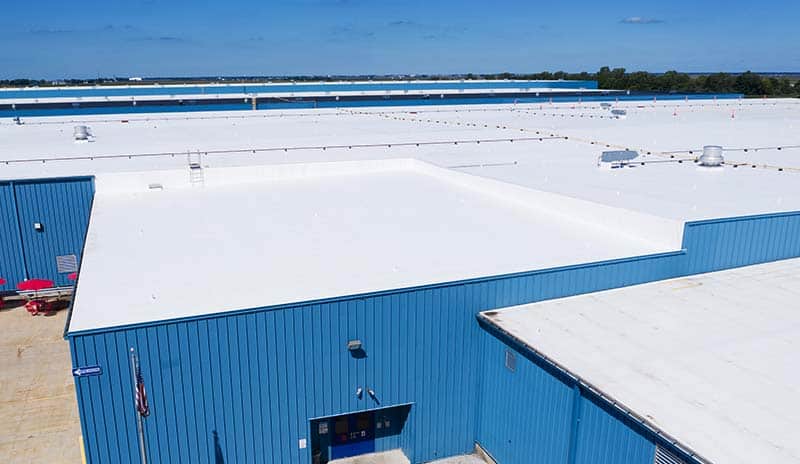Common TPO Roofing Challenges To Consider
One of the most popular types of roofing system you can find is the TPO system which is also known as a single-ply membrane. You could also use a special type of single-ply membrane that is commercially viable which is the Ethylene Propylene Diene Terpolymer (EPDM). However, let’s analyze the Thermoplastic Polyolefin (TPO).
Why use TPO roofing?
There are several benefits to gain from utilizing the TPO roofing system on a commercial roof. It is very durable, strong, and flexible. This kind of roofing is also resistant to tear, accumulation of dirt, and the growth of mold. Its energy efficiency is perhaps the best aspect of the roofing system. The TPO roofing system can resist and reflect high UV rays that usually end up heating commercial buildings. TPO roofing helps in ensuring that the building is cooler and does not require powerful cooling machines to compensate.
TPO Roofing Challenges
1. Easily Punctured Membrane
Most roofers regard TPO roofing as the most problematic for several reasons. The most recurrent is the fact that it is flexible and extremely lightweight and so may not be able to withstand the pressure that is exerted on most commercial buildings. The membrane usually ends up punctured resulting in a leakage.
In more private buildings with limited access, TPO roofs work just fine. With fewer people walking up and down on the top floor, the TPO roofing system might be in jeopardy. The single-ply membrane does not include a hard top layer which usually protects the synthetic rubber layer from objects like stones, tools, or metal.
Most TPO roofing problems that you may see will involve these objects puncturing the rubber membrane layer thereby tearing and breaking the seal and creating holes in the insulation. This leaves your entire roofing system a lot more vulnerable to roof leaks and the accumulation of mold and rot further down the road.
2. Expired warranty
A simple yet effective way to maximize your experience with this roofing system is to purchase a warranty when you install a new roofing system. Most notable manufacturers require contractors to carry out repairs for some years after the installation has been done.
The duration of a warranty could be anywhere from 15 to 30 years. You can solve the most common problems of TPO roofing by simply paying for your warranty at the right time. You must ensure that you constantly monitor the situation to ensure you are not liable for even more expensive repairs and replacements without the warranty.
The necessity of warranties cannot be overemphasized. It will also help you keep your TPO in check especially as you cannot predict just what to expect in extremely rainy climates. You will also be able to protect yourself against persistent problems or recurrent roof bills which make warranties a cost-effective alternative.
3. Degradation of adhesive by UV Rays
The constant wear and tear of the membrane is the most common challenge you can face using this TPO roofing system. This is because this roofing system is constantly exposed to harmful natural elements that constantly cause degradation. This also applies to constant exposure to harmful UV rays that can cause significant damage to the roofing system. UV rays can cause the degradation of the adhesive used in the TPO roofing to attach the membrane firmly to the substrate. Additionally, these adhesives also help in sealing the membrane seams creating a waterproof seal that protects your roof even in the most unfavorable of weather conditions. Without the presence of this seal, your roof is left vulnerable and may ultimately begin accumulating water.
When UV rays begin to harm this seal, you may begin to notice significant damage to your roof in the form of dents, tears, punctures, etc. When these adhesives deteriorate, your roof is not capable of withstanding any pressure applied to the roofing system. This is why it is necessary to ensure that your adhesives and membrane are kept intact.
4. Longevity
Many users of the TPO roofing system complain about the short life span of the roofing system. Although this roofing system is reliable and durable, its technology is fairly recent and so requires more years of experimental work to improve the quality.
The materials used in the TPO roofing system require even more reinforcements to be able to withstand the effects of harmful environmental and natural elements. The formula used in the production of the materials still requires a lot to last longer and avoid problems like seam cracks and material failures. Some significant improvements that have been made to these materials along the way have significantly improved their durability, but they tend to be pricey and difficult to buy which is not a sustainable option for the roofing industry.
The current challenges experienced by users of the TPO roofing systems are relatively easy to solve, and they should always be attended to, to ensure that they do not escalate into an even worse situation.
